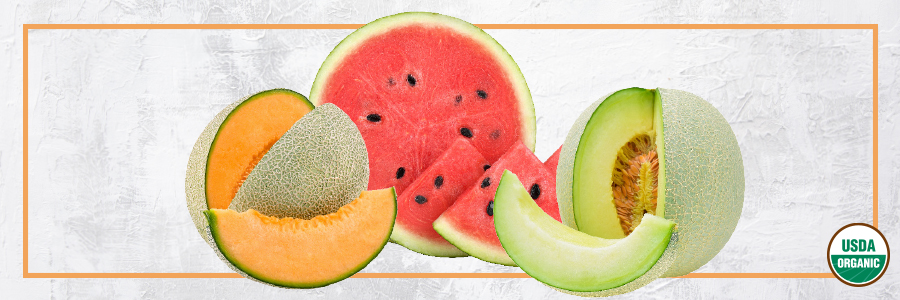


Sign-up for {N}power to get exclusive discounts, newsletters, members-only features, and more!
 Denver - Design District - Alameda and Broadway
Denver - Design District - Alameda and Broadway
368 S Broadway
Denver, CO 80209
United States
 Preferred Store:
Select a Store
Preferred Store:
Select a Store

Whether it’s cantaloupes, watermelons, honeydews, or all the above, you can always count on melons to join the party. At the heart of every carefully crafted charcuterie board, picnic spread, or party platter, melons always seem to make an appearance. Not only are they a sweet and juicy treat to contrast savory cheeses and dips, but melons are also the life of the party, bringing with them a rainbow of colors and a host of health benefits. So don’t forget to put organic melons on the invite list!

A 2022 study showed that prioritizing the wellbeing of local wild bee populations is more important to producing more productive yields of watermelon than prioritizing pest management (i.e., using pesticides).1 Organic farming practices prioritize wild bees by refusing toxic pesticides that wipe out colonies, and instead rely on diversifying crops and planting cover crops like clover to keep bees healthy, happy, and present where their work is needed. So perhaps this gardening season while you sow pollinator-friendly seeds like lavender and calendula flowers, reward your hard work with a refreshing organic melon snack!
 Cantaloupes are the quiet ones at the party. You can always depend on them being there, and though they give off an air of a humble personality, they may just surprise you with their burst of sweetness. Cantaloupes are high in potassium and vitamin C2 and the pigments that give them their beautiful color are also beneficial to our health—the beta carotene that makes cantaloupe orange is an antioxidant that’s well known for supporting healthy eye function.3
Cantaloupes are the quiet ones at the party. You can always depend on them being there, and though they give off an air of a humble personality, they may just surprise you with their burst of sweetness. Cantaloupes are high in potassium and vitamin C2 and the pigments that give them their beautiful color are also beneficial to our health—the beta carotene that makes cantaloupe orange is an antioxidant that’s well known for supporting healthy eye function.3
Party fact: In 2019, a pair of Yubari King melons (a variety of cantaloupe) sold for $45,000 in Japan.4
 This vibrant and versatile fruit brings the fun to the party. Family gatherings, pool parties, and long sunny days in the park, watermelon is the lively one that brings everyone together. Watermelons are packed with vitamins A and C that our bodies need for immune support, nerve function, and skin and eye health.5 Watermelons are also an especially great source of lycopene, a carotenoid that gives these melons their effervescent red color. Lycopene supports heart and brain health, eyesight, fights free radicals, and has even been shown to provide acute protection against UV damage.6 7 Perfect for those parties in the sunshine! (Though, don’t forget to bring the sunscreen, too!)
This vibrant and versatile fruit brings the fun to the party. Family gatherings, pool parties, and long sunny days in the park, watermelon is the lively one that brings everyone together. Watermelons are packed with vitamins A and C that our bodies need for immune support, nerve function, and skin and eye health.5 Watermelons are also an especially great source of lycopene, a carotenoid that gives these melons their effervescent red color. Lycopene supports heart and brain health, eyesight, fights free radicals, and has even been shown to provide acute protection against UV damage.6 7 Perfect for those parties in the sunshine! (Though, don’t forget to bring the sunscreen, too!)
Party fact: A melon worthy of its name, watermelons are made up of 92 percent water.
 Honeydews are the quirky party guests—they’re subdued, yet sweet as honey. It just wouldn’t be a good time without them. Honeydews are rich in vitamins C and K, folate, and potassium. Armed with these nutrients, honeydew supports bone health and the maintenance of bone density. Honeydews are made of 90 percent water, and along with the minerals they contain, like magnesium and potassium, they make a great electrolyte to refuel after a workout or a party by the lake in the sun.8
Honeydews are the quirky party guests—they’re subdued, yet sweet as honey. It just wouldn’t be a good time without them. Honeydews are rich in vitamins C and K, folate, and potassium. Armed with these nutrients, honeydew supports bone health and the maintenance of bone density. Honeydews are made of 90 percent water, and along with the minerals they contain, like magnesium and potassium, they make a great electrolyte to refuel after a workout or a party by the lake in the sun.8
Party fact: Rocky Ford, Colorado is considered the melon capital of the world!
 Try Our Melon Caprese Salad
Try Our Melon Caprese SaladSummer is for salads, but you don’t always have to fall back on leafy greens! This melon caprese salad combines the sweet juiciness of cantaloupe with salty prosciutto and soft buffalo mozzarella cheese, topped with a drizzle of balsamic vinegar—the perfect combo of sweet, savory, and creamy!



Sign-up for {N}power to get exclusive discounts, newsletters, members-only features, and more!
